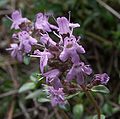- Thymus serpyllum
-
- "Creeping Thyme" and "Wild Thyme" redirect here. In some places, these names refer to Thymus praecox.
Thymus serpyllum 
Scientific classification Kingdom: Plantae (unranked): Angiosperms (unranked): Eudicots (unranked): Asterids Order: Lamiales Family: Lamiaceae Genus: Thymus Species: T. serpyllum Binomial name Thymus serpyllum
L.Thymus serpyllum, known by the common names of Breckland Thyme,[1] Wild Thyme or Creeping Thyme is a species of thyme native to most of Europe and North Africa. It is a low, usually prostrate subshrub growing to 2 cm tall with creeping stems up to 10 cm long, with oval evergreen leaves 3–8 mm long. The strongly scented flowers are either lilac, pink-purple, magenta, or a rare white, all 4–6 mm long and produced in clusters. The hardy plant tolerates some pedestrian traffic and produces odors ranging from heavily herbal to lightly lemon, depending on the plant.
It is part of the Lamiaceae family, and is related to the mint and Dead Nettle plants.
Contents
Uses
Medicinal uses
It is a source of oil of Serpolet by distillation, and is used as an aphrodisiac in herbal medicine. It is also used against coughing.
Food uses
It is used as a seasoning for many meat dishes (being commonly used in beef stews), cabbage or green salads, and vegetable dishes containing zucchini and eggplant. The dried leaves are used for a herbal tea throughout Europe and the United States.
Nectar source
It is an important nectar source plant for honeybees as well as the large blue butterfly which feeds exclusively on wild thyme. All thyme species are nectar sources, but wild thyme covers large areas of droughty, rocky soils in southern Europe. Croatia, Macedonia, Greece, North Africa, Malta, the Berkshire Mountains and Catskill Mountains of the northeastern United States, and New Zealand are especially famous for wild thyme honey. See also: Monofloral honey a
Landscaping
Creeping and mounding variants are used as border plants and ground cover around gardens and stone paths. It may also be used to replace a bluegrass lawn to xeriscape low to moderate foot traffic areas due to its tolerance for low water and poor soils.[2][3][4]
Gallery
Illustrations
References
- ^ Schauer, Thomas (1978). A Field Guide to the Wild Flowers of Britain and Europe, Collins, London, p. 184. ISBN 0-00-219257-8.
- ^ Fine Gardening Magazine, http://www.finegardening.com/design/articles/thyme-the-fragrant-ground-cover.aspx
- ^ Planting and Maintiaining a Thyme Lawn, http://www.gardenguides.com/495-planting-maintiaining-thyme-lawn.html
- ^ Creating Practical Turf Areas, http://www.gardenersgardening.com/xeriscape-dry-climate.html
External links
Categories:- Thymus (genus)
- Herbs
- Flora of Russia
- Flora of Finland
- Flora of Denmark
- Flora of Norway
- Flora of the United Kingdom
- Flora of Germany
- Flora of Estonia
- Flora of Latvia
- Flora of Lithuania
- Flora of France
- Medicinal plants
- Honey plants
- Garden plants of Europe
- Groundcovers
Wikimedia Foundation. 2010.













